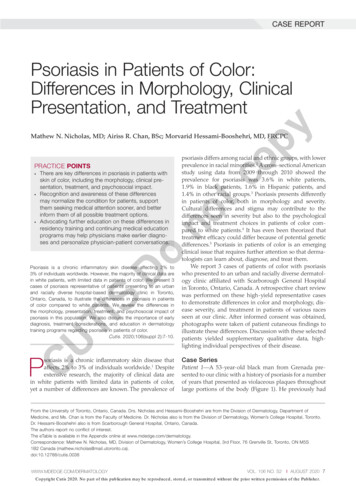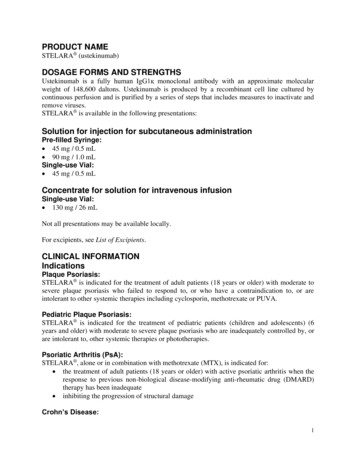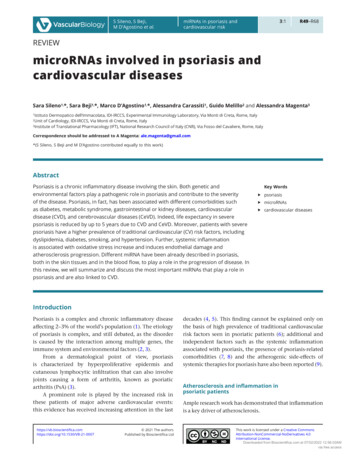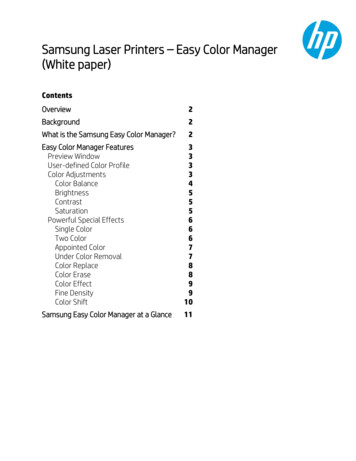
Transcription
CASE REPORTyPsoriasis in Patients of Color:Differences in Morphology, ClinicalPresentation, and Treatment o here are key differences in psoriasis in patients withTskin of color, including the morphology, clinical presentation, treatment, and psychosocial impact. Recognition and awareness of these differencesmay normalize the condition for patients, supportthem seeking medical attention sooner, and betterinform them of all possible treatment options. Advocating further education on these differences inresidency training and continuing medical educationprograms may help physicians make earlier diagnoses and personalize physician-patient conversations.no psoriasis differs among racial and ethnic groups, with lowerprevalence in racial minorities.2 A cross-sectional Americanstudy using data from 2009 through 2010 showed theprevalence for psoriasis was 3.6% in white patients,1.9% in black patients, 1.6% in Hispanic patients, and1.4% in other racial groups.3 Psoriasis presents differentlyin patients of color, both in morphology and severity.Cultural differences and stigma may contribute to thedifferences seen in severity but also to the psychologicalimpact and treatment choices in patients of color compared to white patients.4 It has even been theorized thattreatment efficacy could differ because of potential geneticdifferences.5 Psoriasis in patients of color is an emergingclinical issue that requires further attention so that dermatologists can learn about, diagnose, and treat them.We report 3 cases of patients of color with psoriasiswho presented to an urban and racially diverse dermatology clinic affiliated with Scarborough General Hospitalin Toronto, Ontario, Canada. A retrospective chart reviewwas performed on these high-yield representative casesto demonstrate differences in color and morphology, disease severity, and treatment in patients of various racesseen at our clinic. After informed consent was obtained,photographs were taken of patient cutaneous findings toillustrate these differences. Discussion with these selectedpatients yielded supplementary qualitative data, highlighting individual perspectives of their disease.tcPRACTICE POINTSopMathew N. Nicholas, MD; Airiss R. Chan, BSc; Morvarid Hessami-Booshehri, MD, FRCPCCUTISDPsoriasis is a chronic inflammatory skin disease affecting 2% to3% of individuals worldwide. However, the majority of clinical data arein white patients, with limited data in patients of color. We present 3cases of psoriasis representative of patients presenting to an urbanand racially diverse hospital-based dermatology clinic in Toronto,Ontario, Canada, to illustrate the differences in psoriasis in patientsof color compared to white patients. We review the differences inthe morphology, presentation, treatment, and psychosocial impact ofpsoriasis in this population. We also discuss the importance of earlydiagnosis, treatment considerations, and education in dermatologytraining programs regarding psoriasis in patients of color.Cutis. 2020;106(suppl 2):7-10.Psoriasis is a chronic inflammatory skin disease thataffects 2% to 3% of individuals worldwide.1 Despiteextensive research, the majority of clinical data arein white patients with limited data in patients of color,yet a number of differences are known. The prevalence ofCase SeriesPatient 1—A 53-year-old black man from Grenada presented to our clinic with a history of psoriasis for a numberof years that presented as violaceous plaques throughoutlarge portions of the body (Figure 1). He previously hadFrom the University of Toronto, Ontario, Canada. Drs. Nicholas and Hessami-Booshehri are from the Division of Dermatology, Department ofMedicine, and Ms. Chan is from the Faculty of Medicine. Dr. Nicholas also is from the Division of Dermatology, Women’s College Hospital, Toronto.Dr. Hessami-Booshehri also is from Scarborough General Hospital, Ontario, Canada.The authors report no conflict of interest.The eTable is available in the Appendix online at www.mdedge.com/dermatology.Correspondence: Mathew N. Nicholas, MD, Division of Dermatology, Women’s College Hospital, 3rd Floor, 76 Grenville St, Toronto, ON M5S1B2 Canada tis.0038WWW.MDEDGE.COM/DERMATOLOGYVOL. 106 NO. S2I AUGUST 2020 7Copyright Cutis 2020. No part of this publication may be reproduced, stored, or transmitted without the prior written permission of the Publisher.
PSORIASIS IN PATIENTS OF COLORtcopyinverse psoriasis compared to white patients. Hispanicpatients are more likely to present with pustular psoriasis.11 Black patients have been reported to have lower frequencies of psoriatic arthritis compared to white patients.12Recognition of these differences may help guide initialchoice for therapeutics.Notably, patients of color may present with muchmore severe psoriasis, particularly Asian and Hispanicpatients.7 One retrospective study looking at patientswith psoriasis treated with etanercept found that Asianpatients were more likely to have greater baseline bodysurface area involvement.6 An American cross-sectionalstudy reported higher psoriasis area and severity indexscores in black patients compared to white patients,12noachieved inadequate results while using topical therapies,methotrexate, acitretin, apremilast, ustekinumab, ixekizumab, and guselkumab at adequate or even maximumdoses. His disease affected 30% of the body surface area,with a psoriasis area and severity index score of 27 anda dermatology life quality index score of 23. The patient’slife was quite affected by psoriasis, with emphasis onchoice of clothing worn and effect on body image. He alsodiscussed the stigma psoriasis may have in black patients,stating that he has been told multiple times that “blackpeople do not get psoriasis.”Patient 2—A 27-year-old man from India presented withguttate psoriasis (Figure 2). He was treated with methotrexate 2 years prior and currently is on maintenance therapywith topical treatments alone. His main concerns pertainedto the persistent dyschromia that occurred secondary to thepsoriatic lesions. Through discussion, the patient stated thathe “would do anything to get rid of it.”Patient 3—A 49-year-old man from the Philippinespresented to our clinic with plaque psoriasis that predominantly affected the trunk and scalp (Figure 3). Hehad been treated with methotrexate and phototherapywith suboptimal efficacy and was planning for biologictherapy. Although he had active plaques on the trunk,the patient stated, “I am most bothered by my scalp,” particularly referring to the itch and scale and their effects onhair and hairstyling.oCommentACUTISDClinical differences in patients of color with psoriasisaffect the management of the disease. Special consideration should be given to variances in morphology,presentation, treatment, and psychosocial factors in themanagement of psoriasis for these patient populations,as summarized in the eTable.Morphology—At our clinic, patients of color havebeen found to have differences in morphology, including lesions that are more violaceous in color, as seen inpatient 1; less noticeable inflammation; and more postinflammatory hypopigmentation and hyperpigmentationchanges, as seen in patient 2. These changes are supportedby the literature and differ from typical psoriasis plaques,which are pink-red and have more overlying scale. Thevaried morphology also may affect the differential, andother mimickers may be considered, such as lichen planus,cutaneous lupus erythematosus, and sarcoidosis.2Presentation—There are differences in presentationamong patients of color, particularly in distribution, typeof psoriasis, and severity. As seen in patient 3, Asian andblack patients are more likely to present with scalp psoriasis.2,5 Hairstyling and hair care practices can differ considerably between racial groups. Given the differences inhairstyling, scalp psoriasis also may have a greater impacton patient quality of life (QOL).Racial differences affect the type of psoriasis seen.Asian patients are more likely to present with pustularand erythrodermic psoriasis and less likely to present with8 I CUTIS BFIGURE 1. A and B, Violaceous plaques on the back and arm in ablack patient with psoriasis.WWW.MDEDGE.COM/DERMATOLOGYCopyright Cutis 2020. No part of this publication may be reproduced, stored, or transmitted without the prior written permission of the Publisher.
PSORIASIS IN PATIENTS OF COLORopydifferences in topical treatment efficacy, patient preferencefor different topical treatments may vary based on race.For example, patients with Afro-textured hair may preferfoams and lotions and would avoid shampoo therapies,as frequent hair washing may not be feasible with certainhairstyles and may cause hair breakage or dryness.2UV therapy can be an effective treatment modality forpatients with psoriasis. The strength of therapy tends tobe dictated by the Fitzpatrick skin phototype rather thanrace. Darker-skinned individuals may have an increasedrisk for hyperpigmentation, so caution should be takento prevent burning during therapy. Suberythemogenicdosing—70% of minimal erythema dose—of narrowbandUVB treatments has shown the same efficacy as usingminimal erythema dose in patients with darker skin typesin addition to fair-skinned patients.8Although we found poor efficacy of systemic treatments in patient 1, to our knowledge, studies examiningthe efficacy of systemic therapeutic options have notshown differences in patients of color.6,13 Studies showsimilar efficacy in treatments among races, particularlybiologic therapies.5 However, patients with skin of colorhistorically have been underrepresented in clinical trials,9onotcpossibly because patients of color do not normalize theexperience of having psoriasis and feel stigmatized, whichcan cause delays in seeking medical attention and worsendisease burden. For patient 1, the stigma of black patientshaving psoriasis affected his body image and may haveled to a delay in seeking medical attention due to himnot believing it was possible for people of his skin color tohave psoriasis. Increased disease severity may contributeto treatment resistance or numerous trials of topicals orbiologics before the disease improves. Patient educationin the community as well as patient support groups areparamount, and increased awareness of psoriasis can helpimprove disease management.Treatment—Topical therapies are the first-line treatment of psoriasis. Although there is no evidence showingTISDACUABBFIGURE 2. A and B, Postinflammatory hyperpigmentation from guttatepsoriasis in a patient from India.WWW.MDEDGE.COM/DERMATOLOGYFIGURE 3. A and B, Plaque psoriasis on the scalp and back, respec-tively, in a patient from the Philippines.VOL. 106 NO. 2SI AUGUST 2020 9Copyright Cutis 2020. No part of this publication may be reproduced, stored, or transmitted without the prior written permission of the Publisher.
PSORIASIS IN PATIENTS OF COLORyhas so far been similar, albeit with a low proportion ofpatients with skin of color included in clinical trials.Further focus should now lie within knowledge translation of these differences, which would normalize thecondition for patients, support them seeking medical attention sooner, and inform them of all treatmentoptions possible. For clinicians, more attention on the differences would help make earlier diagnoses, personalizephysician-patient conversations, and advocate for furthereducation on this issue in residency training programs.REFERENCES3.4.5.op2.National Psoriasis Foundation. Statistics. https://www.psoriasis.org/content/statistics. Accessed July 14, 2020.Alexis AF, Blackcloud P. Psoriasis in skin of color: epidemiology,genetics, clinical presentation, and treatment nuances. J Clin AesthetDermatol. 2014;7:16-24.Rachakonda TD, Schupp CW, Armstrong AW. Psoriasisprevalence among adults in the United States. J Am Acad Dermatol.2014;70:512-516.Goff KL, Karimkhani C, Boyers LN, et al. The global burden of psoriaticskin disease. Br J Dermatol. 2015;172:1665-1668.Kaufman BP, Alexis AF. Psoriasis in skin of color: insights into theepidemiology, clinical presentation, genetics, quality-of-life impact,and treatment of psoriasis in non-white racial/ethnic groups. Am J ClinDermatol. 2018;19:405-423.Shah SK, Arthur A, Yang YC, et al. A retrospective study to investigateracial and ethnic variations in the treatment of psoriasis with etanercept. J Drugs Dermatol. 2011;10:866-872.Abrouk M, Lee K, Brodsky M, et al. Ethnicity affects the presentingseverity of psoriasis. J Am Acad Dermatol. 2017;77:180-182.Youssef RM, Mahgoub D, Mashaly HM, et al. Different narrowbandUVB dosage regimens in dark skinned psoriatics: a preliminary study.Photodermatol Photoimmunol Photomed. 2008;24:256-259.Charrow A, Xia F Di, Joyce C, et al. Diversity in dermatology clinicaltrials: a systematic review. JAMA Dermatol. 2017;153:193-198.Takeshita J, Eriksen WT, Raziano VT, et al. Racial differencesin perceptions of psoriasis therapies: implications for racialdisparities in psoriasis treatment. J Invest Dermatol. 2019;139:1672-1679.Yan D, Afifi L, Jeon C, et al. A cross-sectional study of the distributionof psoriasis subtypes in different ethno-racial groups. Dermatol Online J.2018;24. pii:13030/qt5z21q4k2.Kerr GS, Qaiyumi S, Richards J, et al. Psoriasis and psoriatic arthritisin African-American patients—the need to measure disease burden.Clin Rheumatol. 2015;34:1753-1759.Edson-Heredia E, Sterling KL, Alatorre CI, et al. Heterogeneity ofresponse to biologic treatment: perspective for psoriasis. J InvestDermatol. 2014;134:18-23.Yan D, Afifi L, Jeon C, et al. A cross-sectional study of psoriasistriggers among different ethno-racial groups. J Am Acad Dermatol.2017;77:756-758.Bailey RK, Mokonogho J, Kumar A. Racial and ethnic differencesin depression: current perspectives. Neuropsychiatr Dis Treat.2019;15:603-609.Jackson C, Maibach H. Ethnic and socioeconomic disparities in dermatology. J Dermatolog Treat. 2016;27:290-291.Salam A, Dadzie OE. Dermatology training in the U.K.: does itreflect the changing demographics of our population? Br J Dermatol.2013;169:1360-1362.Nijhawan RI, Jacob SE, Woolery-Lloyd H. Skin of color education indermatology residency programs: does residency training reflect thechanging demographics of the United States? J Am Acad Dermatol.2008;59:615-618.Ogunyemi B, Miller-Monthrope Y. The state of ethnic dermatology inCanada. J Cutan Med Surg. 2017;21:464-466.tc1.CUTISDonowhich may contribute to these patients, particularly blackpatients, being less familiar with biologics as a treatment option for psoriasis, as reported by Takeshita et al.10Therefore, patient-centered discussions regarding treatment choices are important to ensure patients understandall options available to manage their disease.Psychosocial Impact—Because of its chronic remittingcourse, psoriasis has a notable psychosocial impact on thelives of all patients, though the literature suggests theremay be more of an impact on QOL in patients of color.Higher baseline dermatology life quality index scoreshave been reported in patients of color compared to whitepatients.6 Kerr et al12 reported significantly greater psoriasis area and severity index scores (P .06) and greaterpsychological impact in black patients compared to whitepatients. Stress also was more likely to be reported as atrigger for psoriasis in patients of Hispanic backgroundcompared to white patients.14 Many patients report bodyimage issues with large physical lesions; however, thedifference may lie in personal and cultural views aboutpsoriasis, as one of our patients stated, “black people donot get psoriasis.” In addition to the cosmetic challengesthat patients face with active lesions, postinflammatory pigmentary changes can be equally as burdensometo patients, as one of our patients stated he “would doanything to get rid of it.” Increased rates of depressionand anxiety in patients of color can worsen their outlookon the condition.15,16 The increased stigma and burden ofpsoriasis in patients of color calls for clinicians to counseland address psoriasis in a holistic way and refer patientsto psoriasis support groups when appropriate. Althoughthe burden of psoriasis is clear, more studies can be carried out to investigate the impact on QOL in differentethnic populations.Dermatology Education—Although differences havebeen found in patients of color with psoriasis, dissemination of this knowledge continues to be a challenge. Indermatology residency programs, the majority of teaching is provided with examples of skin diseases in whitepatients, which can complicate pattern recognition anddiagnostic ability for trainees. Although dermatologistsrecognize that ethnic skin has unique dermatologicconsiderations, there is a persistent need for increasingskin of color education within dermatology residencyprograms.17,18 Implementing more educational programson skin of color has been proposed, and these programswill continue to be in demand as our population increasingly diversifies.19ConclusionPsoriasis in patients of color carries unique challengeswhen compared to psoriasis in white patients. Differencesin morphology and presentation can make the disease difficult to accurately diagnose. These differences in additionto cultural differences may contribute to a greater impacton QOL and psychological health. Although treatmentpreferences and recognition may differ, treatment efficacy10 I CUTIS OM/DERMATOLOGYCopyright Cutis 2020. No part of this publication may be reproduced, stored, or transmitted without the prior written permission of the Publisher.
PSORIASIS IN PATIENTS OF COLORAPPENDIXType of DifferenceCharacteristicMorphologyMore violaceous in color2,ayeTABLE. Notable Differences in Psoriasisin Patients of ColorLess noticeable inflammation2,aMore scalp psoriasis in Asian andblack patients5Potentially greater impact on QOLwith scalp psoriasis2,5,aMore severe disease atpresentation7,aPreference for foams and lotionsfor scalp2,aoTreatmentnoGreater BSA involvement in Asianpatients6tcPresentationopMore postinflammatoryhypopigmentation andhyperpigmentation2,aDUV consideration for prevention ofhyperpigmentation8No known differences in efficacyof systemic treatments5TISPatients with skin of colorunderrepresented in clinical trials9Reduced patient recognition ofcertain treatments10Psychosocial impactHigher DLQI at baseline6,aCUAbbreviations: QOL, quality of life; BSA, body surface area; DLQI,dermatology life quality index.Noted at Scarborough General Hospital, Ontario, Canada.aE10I CUTIS WWW.MDEDGE.COM/DERMATOLOGYCopyright Cutis 2020. No part of this publication may be reproduced, stored, or transmitted without the prior written permission of the Publisher.
training programs regarding psoriasis in patients of color. Cutis. 2020;106(suppl 2):7-10. P soriasis is a chronic inflammatory skin disease that affects 2% to 3% of individuals worldwide.1 Despite extensive research, the majority of clinical data are in white patients with limited data in patients of color, yet a number of differences are known.










